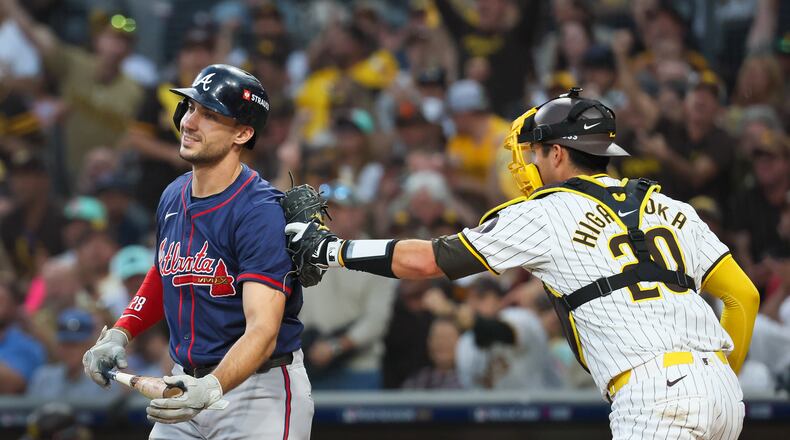SAN DIEGO — A few days ago, there was a plausible path for the Braves through the National League wild-card round. Send out NL Cy Young Award favorite Chris Sale for the opener and win a low-scoring game. Ride the trend of every Game 1 winner of best-of-three wild-card series advancing to the Division Series.
That scenario went south when Sale was left off the wild-card roster because of back spasms. The Braves went to San Diego without a shutdown pitcher to help them steal a victory on Tuesday. It turns out even Sale probably wouldn’t have saved them. The lineup with several fill-ins couldn’t push across a single run against the Padres, who won 4-0 at Petco Park.
This Braves team overcame a long list of injuries to make it this far. They may have finally reached the breaking point. The Braves will try to become the first team to advance out of the best-of-three wild-card round after losing Game 1. That’s a lot to ask of them in their current state.
The flaws that have been there all along are exacerbated by facing a good opponent in the bright glare of October. The Braves are pinning their hopes in Game 2 on lefty Max Fried and a freshened bullpen. The Padres didn’t hit lefties well this season and manager Brian Snitker didn’t use any of his top relief pitchers in Game 1.
But can Braves hitters do much against Game 2 starter Joe Musgrove? They couldn’t touch right-hander Michael King, who recorded 12 strikeouts over seven innings and allowed just five hits (four singles).
“We didn’t score because he did a great job,” Snitker said. “We had some opportunities and (King) made pitches when he had to. It was a lot to do with him instead of us.”
That’s the way it’s been for the Braves for much of this season against great pitchers, lesser arms and those in between. Injuries and underperformance turned a once-fearsome lineup into a group with just two or three hitters who consistently give opponents trouble.
The Braves had a few chances to break through against King. They placed two runners on base in the first, two in the third and one in the fourth. King ended all those threats with strikeouts. The Braves couldn’t do anything with his “sweeper” pitches that dropped nearly three feet and broke more than a foot horizontally.
The Padres scored all the runs they needed in the first inning. Fernando Tatis Jr. smashed a 415-foot, two-run homer against Braves right-hander AJ Smith-Shawver. He recorded just four outs before Snitker pulled him with a 3-0 deficit. It was a bad outing, but I don’t know that any of Snitker’s other options could have done much better.
The pickings were so slim that Snitker and his staff considered calling up Ian Anderson, who hasn’t pitched in MLB since August 2022. Snitker decided against that drastic move and narrowed it down to Smith-Shawver or Bryce Elder. Snitker decided to go with the young pitcher who throws harder with better movement on his pitches.
“You know what, we don’t know any of those guys what we’re going to get when we start them,” Snitker said. “We just had to dip down in (to the depth).”
So, the Braves sent out Smith-Shawver and hoped for the best. He didn’t have his usual velocity on his pitches early in Game 1. His fastball averaged 96 mph during his start at the Cubs in May and 95 mph in Triple-A, but it was around 93 to begin this game.
“You’re just trying to get out there and throw a few over the plate and trying to get settled in, and then whenever you need to you can step on it,” Smith-Shawver said.
That sounds like a good idea when ramping up during spring training. It’s a terrible plan when facing a dangerous lineup on the road in October. Smith-Shawver threw fastballs with less than maximum effect and the Padres punished him for it.
The Braves can expect better from Fried. His past two October outings weren’t good, but Fried was dealing with an injury in 2022 and an illness in 2023 when facing the Phillies in the NLDS. Fried has no known issues this time. That’s a positive for the Braves in Game 2.
The counterpoint is they need to score runs. That’s been a problem all year. The light-hitting, makeshift lineup did just enough for them to scrape by over 162 games. It’s a lot harder to do it against the Padres, who’ve lined up their healthy pitchers in the order they want.
The Braves also must buck the trend of every Game 1 loser in the wild-card series before this year. MLB expanded the wild-card round from one game to best-of-three in 2022. The eight teams that won the first game of the series all went on to the NLDS. Only one of those eight series even went to three games. The Padres beat the Mets in Game 2 of the 2022 wild-card round before losing Game 3.
The Braves will try to do that Padres team one better by winning the next two games in San Diego. They’ll try to regain the momentum they had before this week. The Braves didn’t clinch a postseason berth until winning the final game on Monday against the Mets, who had no incentive to go all-out.
Then came the news that Sale wouldn’t pitch in the wild-card series. The Braves won’t get a chance to steal a game with Sale on the mound. They couldn’t even score a run in Game 1. Credit the Braves for making it here, but it looks like this is where the season will end for them.
About the Author
Keep Reading
The Latest
Featured


